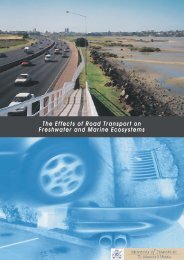Auckland City Centre Rail Link - Business Case Review - Ministry of ...
Auckland City Centre Rail Link - Business Case Review - Ministry of ...
Auckland City Centre Rail Link - Business Case Review - Ministry of ...
Create successful ePaper yourself
Turn your PDF publications into a flip-book with our unique Google optimized e-Paper software.
<strong>Auckland</strong> <strong>City</strong> <strong>Centre</strong> <strong>Rail</strong> <strong>Link</strong> <strong>Business</strong> <strong>Case</strong> <strong>Review</strong> | May 2011<br />
However, these are measures that will extract some limited additional capacity out <strong>of</strong><br />
the network rather than ones that will form an enduring solution to the capacity<br />
constraint itself.<br />
1.1.2 Bus service constraints<br />
While the <strong>Business</strong> <strong>Case</strong> discussed constraints around further development <strong>of</strong> the<br />
bus system in the central city, it did not consider external measures that might<br />
address some <strong>of</strong> the bus system issues in the central city, which might influence the<br />
timing <strong>of</strong> the CCRL. Such factors include:<br />
the absence, until the end <strong>of</strong> 2012, <strong>of</strong> integrated ticketing facilitating multimodal<br />
journeys<br />
the general absence <strong>of</strong> timed integration between bus and train services at<br />
key interchanges — this integration has been a practice <strong>of</strong> the Wellington<br />
public transport system for many years<br />
sub-optimal operations <strong>of</strong> the Britomart bus interchange which reduces its<br />
operational performance and does not optimise intermodal connectivity for<br />
customers<br />
the widespread distribution <strong>of</strong> bus terminal stops throughout the core CBD,<br />
making it difficult to transfer between many services<br />
relatively poor central area circulator services, especially to the fast-growing<br />
Wynyard Quarter — although <strong>Auckland</strong> Transport is planning to make<br />
significant progress in this area later in 2011<br />
conflict between different service groups in the same corridors, such as<br />
between northern and western bus services on Albert Street, which reduces<br />
the effectiveness <strong>of</strong> existing bus priority measures<br />
While these issues constitute a significant challenge to optimise bus operation in the<br />
central city, their resolution would mostly contribute to a rationalised and more<br />
integrated central area bus network, rather than one that would add major new<br />
capacity. This is due to the constraints <strong>of</strong> the existing street network, particularly on<br />
the eastern side <strong>of</strong> the city centre, the limited ability to add significant new bus priority<br />
measures across the city centre without unduly compromising its place function, and<br />
the need to appropriately balance the needs <strong>of</strong> all road user groups. Also <strong>of</strong> note is<br />
that the bulk <strong>of</strong> the central area bus network serves areas without rail, particularly the<br />
bulk <strong>of</strong> the <strong>Auckland</strong> Isthmus and the whole <strong>of</strong> the North Shore and the Hibiscus<br />
Coast.<br />
Any reduction in bus volumes by improving integration with rail would most likely be<br />
taken up by improved service frequencies from other areas.<br />
1.2 The <strong>Review</strong> position<br />
The government is currently undertaking a $1.1 billion programme to upgrade and<br />
electrify the <strong>Auckland</strong> metro rail network (alongside a further $500 million for new<br />
trains expected to be funded by the <strong>Auckland</strong> Council and NZ Transport Agency<br />
(NZTA), and ongoing <strong>Auckland</strong> Council and NZTA investment in rail stations). This<br />
will improve the frequency, speed, reliability and quality <strong>of</strong> rail services. The former<br />
<strong>Auckland</strong> Regional Transport Authority‘s <strong>Rail</strong> Development Plan notes that the<br />
investment in electrification will:<br />
reduce congestion, improving freight travel times and road user journey time<br />
reliability<br />
encourage intensification <strong>of</strong> development along rail corridors<br />
increase economic activity and labour productivity in the CBD<br />
50
















